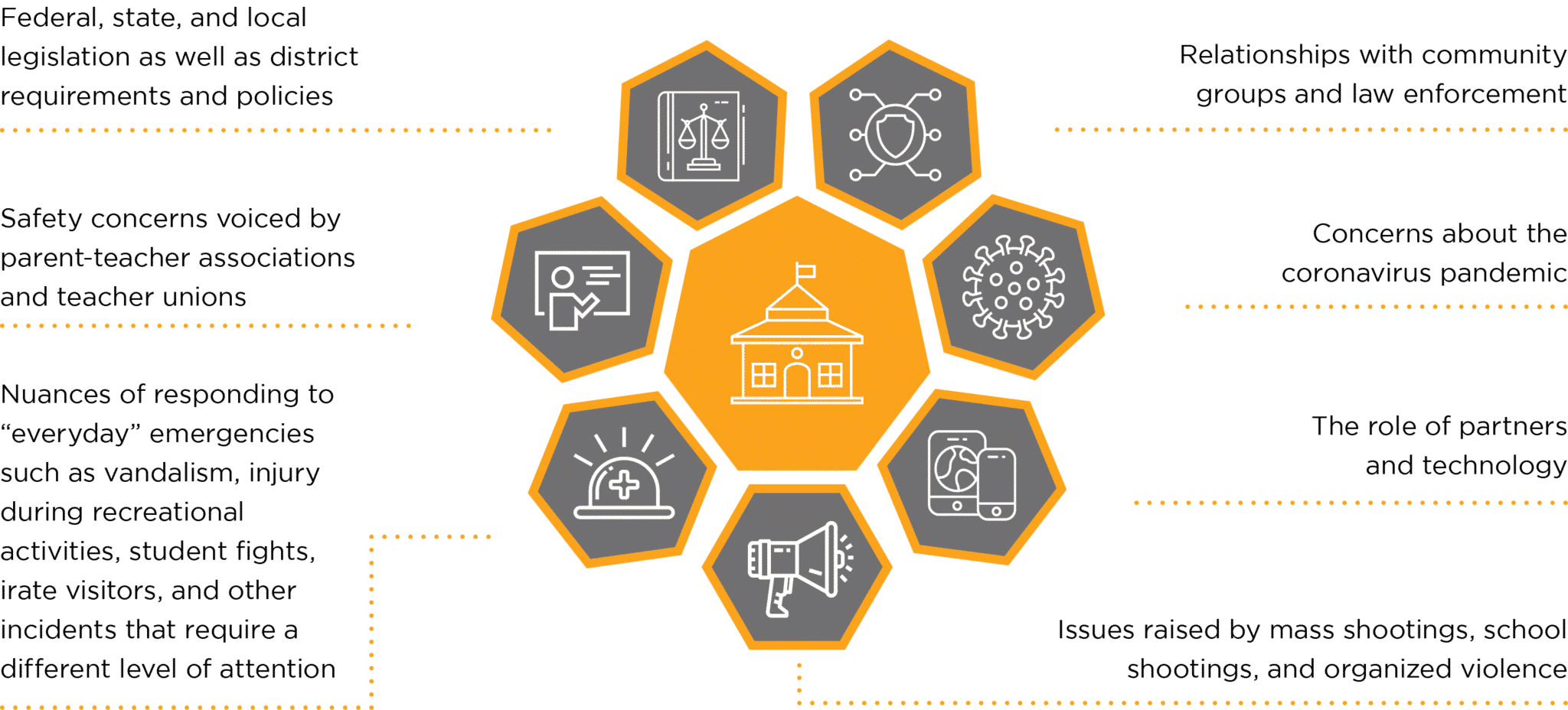This article originally appeared on The Journal of School Safety. To view the original article, click here.
School resource officers (SROs) play a vital role in developing and implementing critical emergency management practices in their schools. This can be challenging, as there are always new considerations around safety, changes to statutes and regulations, and professional as well as cultural shifts to account for. These considerations can vary drastically not only from state to state or county to county, but sometimes even between buildings in the same district.
This article shares proven strategies and best practices to position you in collaboration with your school safety team and school administrators to design an approach for your school that includes: preparing for emergencies, managing localized incidents, alerting first responders, accounting for students, reunifying students with their guardians, and continuously adjusting policies considering new threats. The Journal of School Safety

Safety is the number one consideration in any discussion about emergency management. Yet that discussion is informed by several factors from the immediate community to the larger social and political landscape.
The Three Stages of Emergency Management
Emergency management can be organized around three central themes: prepare, respond, and recover.
Prepare
The first major step in effective school safety is developing an emergency operations plan (EOP) that defines the actions everyone should take during an incident. These protocols provide consistent instructions for students, staff, SROs, and first responders and a collective understanding that allows for quick and coordinated action.

When developing or reevaluating your EOP, concentrate on these five objectives.
Practicing Your EOP with Drills and Exercises
Drills prepare your school to confidently respond and keep everyone safe in an actual crisis. SROs should be involved in every drill for practice and to ensure the drill strictly follows the EOP. SROs can also leverage their relationships with public safety and first responders to include these outside agencies in applicable drills or exercises, which will ultimately expedite response since everyone will be familiar with each individuals responsibilities, roles, and needed actions.
It’s critical that your school safety team, representatives from outside agencies (if applicable), and students and staff debrief after each drill. This assessment helps determine if anything needs to be changed or improved. To do this well, you need a method of tracking drill data and creating comprehensive reports that show what is working and how you can better your response. These reports also enable you to demonstrate compliance with state and district requirements.
It’s one thing to say you conducted a drill; it’s another to prove it with documentation and to have that documentation at your fingertips.
– Director, Duval County School Police Department
Respond
In the event of an actual emergency, you’ll want the right people, actions, and tools in the field to keep people safe and resolve the issue as soon as possible.
Expediting Awareness
SROs are at the forefront of reducing, resolving, and responding to school emergencies, but it is impossible to be everywhere on campus at once. Best practice is for teachers, staff, and SROs to have a mobile panic button that they can initiate from wherever they are on campus.
For example, if an intruder with a weapon approaches the marching band outside, the band director can quickly and discreetly initiate a panic button and instantly summon help. Ideally the system can send detailed, situation-specific alerts to SROs and first responders so they know exactly why and where their quick presence is needed.
The most powerful panic button systems are customized to your emergency response protocols and enable users to directly connect with 9-1-1, share their location on an interactive map, and allow staff, first responders, and incident commanders to communicate through group messaging and access your protocols and building floor plans.
Everyday, Localized Incidents
Planning for wide-scale emergencies is critical, but issues related to localized incidents are more frequent. You’ve probably already responded to more than one irate visitor, student fight, or medical incident like an allergic reaction. A panic button system should allow teachers and staff to summon help for these localized scenarios that SROs or other appropriate staff can handle.
Accounting for Everyone
Imagine an emergency begins during an assembly when students and visitors are dispersed. Flipping through paper rosters and visitor logbooks to account for everyone and mark those who are injured or missing can be incredibly cumbersome. An accountability solution one that is ideally integrated with the panic button system enables teachers and staff to quickly account for anyone, whether that be a student in their class, a student that isn’t on their roster, another staff member, or a visitor. As they account for individuals on campus, SROs, first responders, and incident commanders see the updates in real-time and can receive details of each individual, including their location, status, medical conditions, allergies, and if they are students, their guardians contact information. This information can help SROs and first responders better determine next steps, assess the situation, and know where to prioritize their response.
Recover
Alongside how to respond to an incident, districts also need a robust plan for every component of reunifying students with their approved guardian.
Reunification Team and Site
Best practice includes a reunification team that is responsible for reunifying students and transporting teachers and staff back to the school as well as a transport team that facilitates transportation and initiates accountability processing in off-site reunifications. The reunification facility should be a nearby facility that is unoccupied during the school day and is large enough to hold your school population, guardians, and volunteers. The facility should have large rooms where you can divide your students into groups. The schools reunification procedure also needs to specify predetermined routes for getting students, staff, security, first responders, and other personnel to and from the site.

Before the school year starts, you should complete these tasks to confirm your reunification procedure.
Keep Everyone Calm
District security, SROs, and law enforcement personnel should be present to foster a sense of safety and minimize chaos. If media representatives arrive, security and law enforcement officials can also ensure reporters wont interfere with reunification. School-employed mental health professionals should also be present at the site to help with any crisis-related needs.
Streamline Reunification
Knowing student status including if the student is missing or injured is critical, but this data can easily be lost in the chaos of pen-and-paper reunification methods. Teachers, staff, SROs, first responders, and incident commanders need instant access to real-time student data, status, and location. Its also imperative that personnel can accurately confirm the guardians identity, check for sex offender status, check for custodial restrictions, and capture their signature at reunification. Using a reunification solution can improve your process, eliminate inaccuracy, and ensure you release students only to approved guardians.?
Movements and Changes in K-12 Emergency Management
Emergency management is not a static set of ideas or actions. New threats and political and legal developments require us to reevaluate how we can continue to keep students safe. One of these legal developments is Alyssas Law, which is named after Alyssa Alhadeff, a victim of the Marjory Stoneman Douglas High School tragedy. It requires schools to have silent panic button systems linked to first responder and law enforcement agencies. Even if you’re not legally obligated to comply in your region, following the guidelines is part of well-rounded emergency management approach.
Schools have shown incredible dedication and innovation as COVID-19 has forced them to readjust many protocols. Now, schools must continue COVID-19 response while supporting daily operations, focusing on safety, and following key practices. Not following basic school safety best practices can put the school in harm. For example, schools may want to prop open doors to avoid people touching handles but consider what would happen if the school needed to go on lockdown. Staff would have to manually shut and lock those doors and when every second counts in an emergency that process could be the difference in a successful emergency response or a tragic situation. Open doors also allow violent intruders or unwanted entrants easier access to your buildings. Its also imperative to update your EOP for pandemic response and any adjustments you have made.
Partnering with a School Safety Expert
There is no last step to school safety. When evaluating emergency management solutions, its just as important to pick the right company as it is the right product since the two will go hand in hand. Since 2002 Raptor Technologies has been the nations leading provider of school safety software solutions. Today, over 35,000 K-12 schools nationwide are protected by a Raptor integrated safety solution. Raptor Emergency Management seamlessly integrates with Raptor Visitor Management and Raptor Volunteer Management to ensure that you remain in complete control and have line of sight to everyone and every incident in your schools every day.
To learn more about Raptor, visit us online at www.raptortech.com or call 877-772-7867.





